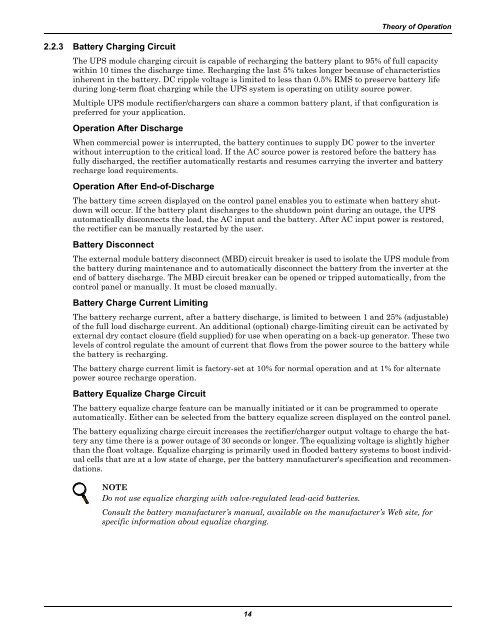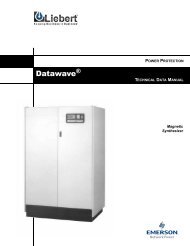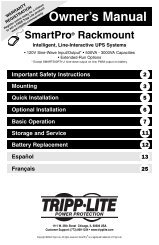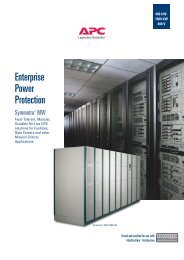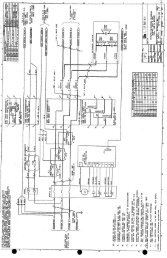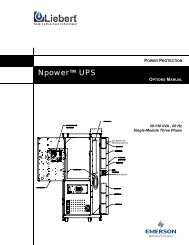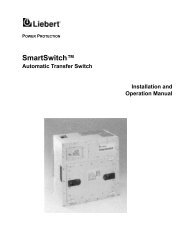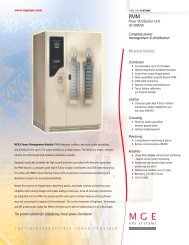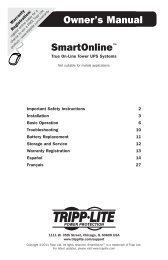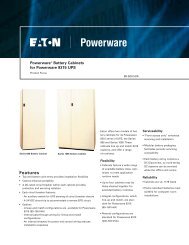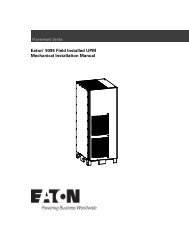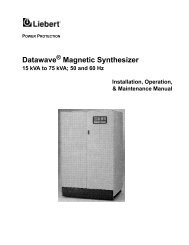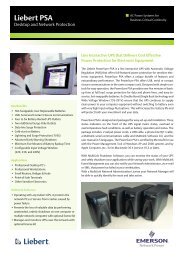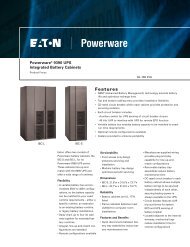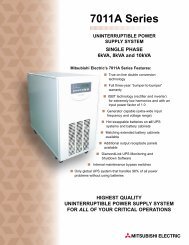Liebert® Series 610™ UPS - Jonweb.net
Liebert® Series 610™ UPS - Jonweb.net
Liebert® Series 610™ UPS - Jonweb.net
You also want an ePaper? Increase the reach of your titles
YUMPU automatically turns print PDFs into web optimized ePapers that Google loves.
2.2.3 Battery Charging Circuit<br />
Theory of Operation<br />
The <strong>UPS</strong> module charging circuit is capable of recharging the battery plant to 95% of full capacity<br />
within 10 times the discharge time. Recharging the last 5% takes longer because of characteristics<br />
inherent in the battery. DC ripple voltage is limited to less than 0.5% RMS to preserve battery life<br />
during long-term float charging while the <strong>UPS</strong> system is operating on utility source power.<br />
Multiple <strong>UPS</strong> module rectifier/chargers can share a common battery plant, if that configuration is<br />
preferred for your application.<br />
Operation After Discharge<br />
When commercial power is interrupted, the battery continues to supply DC power to the inverter<br />
without interruption to the critical load. If the AC source power is restored before the battery has<br />
fully discharged, the rectifier automatically restarts and resumes carrying the inverter and battery<br />
recharge load requirements.<br />
Operation After End-of-Discharge<br />
The battery time screen displayed on the control panel enables you to estimate when battery shutdown<br />
will occur. If the battery plant discharges to the shutdown point during an outage, the <strong>UPS</strong><br />
automatically disconnects the load, the AC input and the battery. After AC input power is restored,<br />
the rectifier can be manually restarted by the user.<br />
Battery Disconnect<br />
The external module battery disconnect (MBD) circuit breaker is used to isolate the <strong>UPS</strong> module from<br />
the battery during maintenance and to automatically disconnect the battery from the inverter at the<br />
end of battery discharge. The MBD circuit breaker can be opened or tripped automatically, from the<br />
control panel or manually. It must be closed manually.<br />
Battery Charge Current Limiting<br />
The battery recharge current, after a battery discharge, is limited to between 1 and 25% (adjustable)<br />
of the full load discharge current. An additional (optional) charge-limiting circuit can be activated by<br />
external dry contact closure (field supplied) for use when operating on a back-up generator. These two<br />
levels of control regulate the amount of current that flows from the power source to the battery while<br />
the battery is recharging.<br />
The battery charge current limit is factory-set at 10% for normal operation and at 1% for alternate<br />
power source recharge operation.<br />
Battery Equalize Charge Circuit<br />
The battery equalize charge feature can be manually initiated or it can be programmed to operate<br />
automatically. Either can be selected from the battery equalize screen displayed on the control panel.<br />
The battery equalizing charge circuit increases the rectifier/charger output voltage to charge the battery<br />
any time there is a power outage of 30 seconds or longer. The equalizing voltage is slightly higher<br />
than the float voltage. Equalize charging is primarily used in flooded battery systems to boost individual<br />
cells that are at a low state of charge, per the battery manufacturer's specification and recommendations.<br />
NOTE<br />
Do not use equalize charging with valve-regulated lead-acid batteries.<br />
Consult the battery manufacturer’s manual, available on the manufacturer’s Web site, for<br />
specific information about equalize charging.<br />
14


